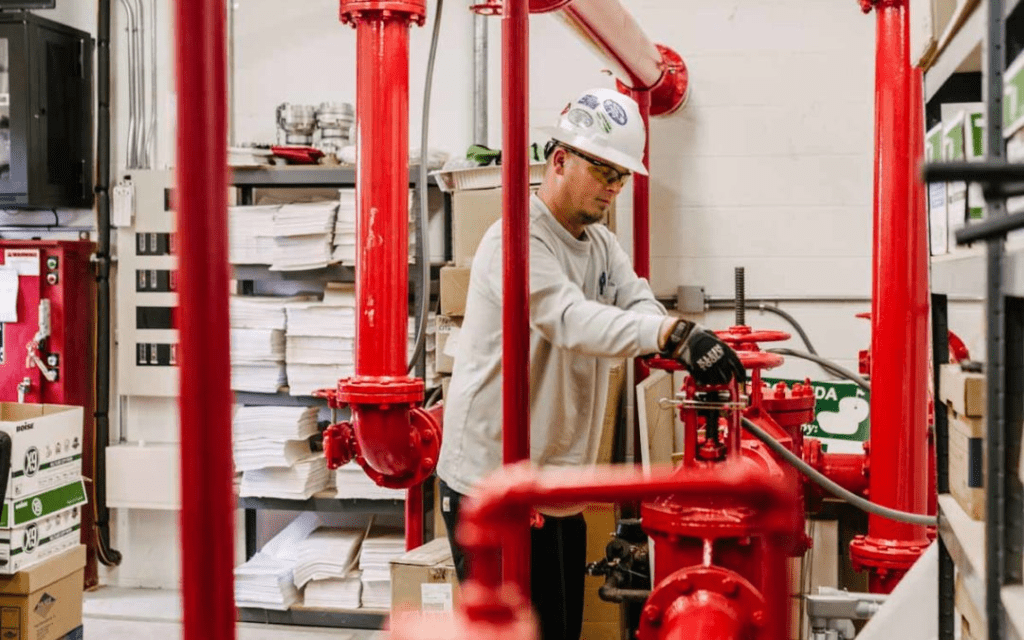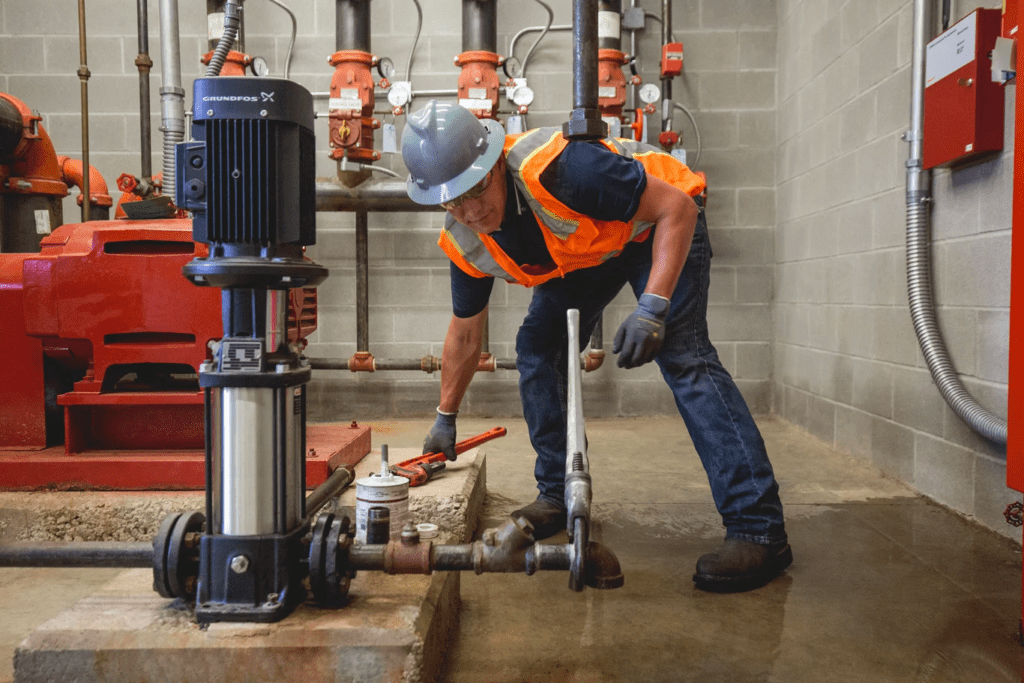When it comes to fire safety in buildings, one critical component often overlooked is the fire pump room. This essential area houses the heart of a building’s fire suppression system – the fire pump. Proper maintenance of this room and its equipment is not just a matter of regulatory compliance; it’s a vital aspect of ensuring the safety of building occupants and protecting valuable assets. In this post, we’ll explore why fire pump room maintenance is so important and what it entails.
The Critical Role of Fire Pump Rooms:

Fire pump rooms play a pivotal role in a building’s fire protection system. They house the fire pump, which is responsible for boosting water pressure and flow to sprinkler systems and standpipes throughout the building. In the event of a fire, this equipment can mean the difference between minor damage and catastrophic loss.
Key Reasons for Proper Fire Pump Room Maintenance:

1. Ensuring Operational Readiness:
Regular maintenance ensures that the fire pump and associated equipment are always ready to perform when needed. Fire emergencies are unpredictable, and equipment failure during a critical moment can have devastating consequences.
2. Compliance with Fire Codes:
Proper maintenance is not just good practice; it’s often mandated by local and national fire codes. Regular inspections and maintenance help building owners stay compliant with these regulations, avoiding potential fines and legal issues.
3. Prolonging Equipment Lifespan:
Like any mechanical system, fire pumps and their components benefit from regular care. Proper maintenance can significantly extend the life of this expensive equipment, saving building owners money in the long run.
4. Early Problem Detection:
Regular inspections as part of a maintenance routine can help identify potential issues before they become major problems. This proactive approach can prevent unexpected breakdowns and costly emergency repairs.
5. Maintaining Building Safety:
A well-maintained fire pump room contributes to the overall safety of the building. It ensures that in the event of a fire, the suppression system will work as intended, potentially saving lives and minimizing property damage.
What Proper Maintenance Involves:
Effective fire pump room maintenance includes regular inspections, testing, and servicing of all components. This typically involves:
- Checking pump casings, impellers, and seals
- Inspecting electrical systems and controls
- Testing pump performance and pressure
- Maintaining proper environmental conditions in the pump room
- Ensuring clear access to all equipment
- Keeping accurate maintenance records
Fire Pump Maintenance Requirements by NFPA Standards

The National Fire Protection Association (NFPA) sets comprehensive standards for fire pump maintenance, inspection, testing, and repair. These guidelines are crucial for ensuring the reliability and effectiveness of fire protection systems. Let’s delve into the key NFPA requirements for fire pump maintenance:
- Weekly Inspections:
- NFPA 25 mandates weekly visual inspections of fire pump systems.
- Check pump room temperature (must be above 40°F for electric pumps, 70°F for diesel).
- Verify all valves are in the correct open or closed positions.
- Ensure adequate fuel levels for diesel pumps.
- Check for any visible leaks in the system.
- Monthly Tests:
- Conduct a no-flow test by starting the fire pump and running it for a minimum of 10 minutes.
- For diesel pumps, run for 30 minutes to prevent wet stacking.
- Record the starting pressures, running pressures, and time for the pump to reach rated speed.
- Annual Tests:
- Perform a full flow test annually to verify the pump meets its rated capacity.
- Test at 100%, 150%, and 70% of rated flow.
- Measure and record flow rates, suction and discharge pressures, and pump speed.
- Inspect all components, including controllers, transfer switches, and power supplies.
- Fire Pump Repair and Service:
- Any deficiencies found during inspections or tests must be addressed promptly.
- Only qualified personnel should perform repairs on fire pump systems.
- Keep detailed records of all repairs and services performed.
- Documentation:
- Maintain thorough records of all inspections, tests, and maintenance activities.
- Documentation should include date, results, and any actions taken.
- These records must be available for review by fire code officials.
- Training Requirements:
- NFPA standards require that personnel conducting inspections, tests, and maintenance be properly trained.
- Training should cover the specific equipment installed and the facility’s fire protection plan.
- Automated Testing Systems:
- If using automated testing systems, ensure they comply with NFPA 25 requirements.
- Regular manual inspections are still necessary to complement automated systems.
- Impairment Procedures:
- Develop and follow proper impairment procedures when taking fire pumps out of service for maintenance or repairs.
- Notify the fire department and insurance company when major components are impaired.
- Frequency of Major Services:
- Complete overhaul of fire pump systems is typically recommended every 5-7 years, depending on usage and environment.
- This may include rebuilding pumps, replacing seals, and updating control systems.
By adhering to these NFPA standards for fire pump maintenance, building owners and facility managers can ensure their fire protection systems remain in optimal condition. Regular maintenance not only complies with fire code regulations but also provides peace of mind that the system will perform as expected in an emergency.
Developing a Comprehensive Fire Pump Maintenance Checklist

A well-structured fire pump maintenance checklist is essential for ensuring thorough and consistent upkeep of your fire protection system. Here’s how to develop a comprehensive checklist that covers all critical aspects of fire pump maintenance:
1. Daily Checks:
- Verify pump room temperature (above 40°F for electric, 70°F for diesel)
- Check pump room for any water leaks or unusual noises
- Ensure all valves are in the correct position
- Verify fuel levels for diesel pumps
- Check battery charger status (for diesel pumps)
2. Weekly Inspections:
- Inspect pump casing and seals for leaks
- Check coupling alignment
- Verify lubrication levels
- Inspect electrical connections for tightness
- Test alarm systems
- Run pump briefly to check for any abnormalities
3. Monthly Tests:
- Perform no-flow pump test (churn test)
- Record suction and discharge pressures
- Measure time to reach rated speed
- Check packing gland for proper drip rate
- Inspect drive shaft and bearings
- Test automatic transfer switch (if applicable)
4. Quarterly Tasks:
- Lubricate pump bearings
- Check shaft endplay
- Inspect and clean strainers and filters
- Test all gauges and replace as needed
- Verify accuracy of pressure sensing lines
5. Annual Comprehensive Inspection:
- Conduct full flow test at 100%, 150%, and 70% of rated capacity
- Analyze pump performance curves
- Inspect and test all valves (OS&Y, check, relief)
- Evaluate controller operations and settings
- Test all alarms and signals
- Inspect suction and discharge piping
- Review and update fire pump room signage
6. Fire Pump Room Inspection:
- Check ventilation systems
- Ensure proper lighting
- Verify clear access to all equipment
- Inspect fire-rated walls and doors
- Check for any potential hazards or obstructions
7. Preventive Maintenance Tasks:
- Replace packing or mechanical seals as needed
- Service or replace batteries for diesel pumps
- Update firmware on digital controllers
- Calibrate pressure and flow sensors
- Repaint pump and piping to prevent corrosion
8. Troubleshooting Checklist:
- Document common issues and their solutions
- Include step-by-step procedures for diagnosing problems
- List contact information for specialized technicians
9. Documentation:
- Record all test results, maintenance activities, and repairs
- Note any parts replaced and their specifications
- Keep track of pump run times and starts
- Maintain an inventory of spare parts
10. Safety Procedures:
- Outline lockout/tagout procedures
- List required personal protective equipment (PPE)
- Include emergency shutdown procedures
11. Compliance Checks:
- Verify alignment with latest NFPA standards
- Ensure all required tests are scheduled and performed
- Keep certificates of inspection up to date
By implementing this comprehensive checklist, you can ensure that all aspects of fire pump maintenance are regularly addressed. This proactive approach helps maintain the reliability of your fire protection system, ensures compliance with regulations, and contributes to overall building safety.
Remember to regularly review and update your checklist to incorporate any changes in equipment, regulations, or best practices.
Common Fire Pump Issues and How to Address Them

Even with regular maintenance, fire pumps can experience various issues. Recognizing these problems early and addressing them promptly is crucial for maintaining an effective fire protection system. Here are some common fire pump problems and their solutions:
1. Failure to Start:
Problem: The pump doesn’t activate when signaled.
Possible causes:
– Electrical issues (for electric pumps)
– Dead batteries or fuel problems (for diesel pumps)
– Controller malfunction
Solution:
– Check power supply and connections
– Inspect and replace batteries if necessary
– Verify fuel quality and quantity
– Test and repair/replace controller components
2. Low Pressure or Flow:
Problem: Pump isn’t delivering adequate pressure or flow rate.
Possible causes:
– Impeller wear or damage
– Clogged strainers or piping
– Air in the system
– Incorrect pump sizing
Solution:
– Inspect and replace impeller if worn
– Clean strainers and check for pipe obstructions
– Bleed air from the system
– Verify pump specifications match system requirements
3. Overheating:
Problem: Pump operates at high temperatures.
Possible causes:
– Insufficient water flow
– Bearing failure
– Improper alignment
– Inadequate ventilation in pump room
Solution:
– Check for closed valves or blockages
– Inspect and replace bearings if necessary
– Realign pump and motor
– Improve pump room ventilation
4. Excessive Vibration:
Problem: Pump vibrates excessively during operation.
Possible causes:
– Misalignment
– Loose mounting bolts
– Worn bearings
– Impeller imbalance
Solution:
– Realign pump and motor
– Tighten all mounting hardware
– Replace worn bearings
– Balance or replace impeller
5. Leaks:
Problem: Water leakage from pump casing or seals.
Possible causes:
– Worn mechanical seals or packing
– Cracked pump casing
– Loose fittings
Solution:
– Replace mechanical seals or repack as needed
– Inspect casing for cracks and repair/replace if necessary
– Tighten all fittings and connections
6. Controller Issues:
Problem: Erratic behavior or failure of the pump controller.
Possible causes:
– Electrical faults
– Software glitches
– Sensor failures
Solution:
– Check all electrical connections
– Update controller firmware
– Replace faulty sensors
– Consult manufacturer for complex issues
7. Cavitation:
Problem: Noisy operation and potential damage due to vapor bubbles.
Possible causes:
– Insufficient suction pressure
– Air in the suction line
– Partially closed suction valve
Solution:
– Verify and correct suction line conditions
– Bleed air from the system
– Ensure all suction valves are fully open
8. Frequent Cycling:
Problem: Pump starts and stops frequently.
Possible causes:
– Faulty pressure switch
– System leaks
– Waterlogged pressure tank
Solution:
– Adjust or replace pressure switch
– Locate and repair system leaks
– Check and recharge pressure tank
9. Reduced Performance Over Time:
Problem: Gradual decline in pump efficiency.
Possible causes:
– Normal wear and tear
– Changing system demands
– Accumulated deposits in piping
Solution:
– Schedule comprehensive maintenance
– Reassess system requirements
– Clean and flush piping system
10. Complete Pump Failure:
Problem: Pump ceases to function entirely.
Possible causes:
– Major mechanical failure
– Severe electrical damage
– End of service life
Solution:
– Conduct thorough assessment
– Determine if repair is feasible or if replacement is necessary
– Consider upgrading to a more efficient model if replacing
When addressing these issues, always consult the pump’s manual and follow manufacturer guidelines. For complex problems or when in doubt, it’s best to engage certified fire pump technicians to ensure proper diagnosis and repair. Regular maintenance and prompt attention to minor issues can prevent many of these problems and extend the life of your fire pump system.
Certainly. Here’s a section on “Outsourcing Fire Pump Maintenance vs. In-House Management”:
Outsourcing Fire Pump Maintenance vs. In-House Management

When it comes to fire pump maintenance, building owners and facility managers often face the decision of whether to outsource this critical task or manage it in-house. Both approaches have their merits and challenges. Let’s explore the pros and cons of each option to help you make an informed decision.
Outsourcing Fire Pump Maintenance:
Pros:
1. Expertise: Professional fire pump maintenance services employ certified technicians with specialized knowledge and experience.
2. Up-to-date knowledge: Contractors stay current with the latest fire codes, regulations, and maintenance techniques.
3. Advanced equipment: Service providers typically have access to specialized tools and diagnostic equipment.
4. Liability protection: Outsourcing can transfer some liability risks to the contractor.
5. Time-saving: Frees up in-house staff to focus on other facility management tasks.
Cons:
1. Cost: Professional services can be more expensive than in-house maintenance, especially for routine tasks.
2. Scheduling challenges: You may need to work around the contractor’s availability.
3. Less familiarity with your specific system: External technicians may take time to become familiar with your particular setup.
In-House Fire Pump Maintenance Management:

Pros:
1. Cost-effective for routine tasks: Can be more economical for regular inspections and basic maintenance.
2. Immediate response: In-house staff can quickly address minor issues as they arise.
3. System familiarity: Your team will develop an in-depth understanding of your specific fire pump system.
4. Customized maintenance schedule: Easier to tailor the maintenance routine to your facility’s needs.
Cons:
1. Training requirements: Significant investment in training staff to meet certification requirements.
2. Equipment costs: Need to purchase and maintain specialized tools and testing equipment.
3. Liability concerns: The organization bears full responsibility for maintenance quality and compliance.
4. Resource allocation: Requires dedicated staff time, which may detract from other responsibilities.
Factors to Consider When Deciding:
1. Facility size and complexity: Larger facilities with multiple pump systems may benefit more from outsourcing.
2. Staff expertise: Assess your team’s current knowledge and capacity to take on specialized maintenance.
3. Budget considerations: Compare long-term costs of both options, including training and equipment for in-house management.
4. Regulatory environment: Consider the complexity of local fire codes and the consequences of non-compliance.
5. Frequency of required maintenance: More frequent or complex maintenance may favor outsourcing.
Best Practices for Either Approach:
1. Develop a comprehensive maintenance plan: Whether in-house or outsourced, have a clear schedule and checklist.
2. Keep detailed records: Maintain thorough documentation of all maintenance activities, regardless of who performs them.
3. Stay informed: Keep up with changes in fire pump technology and maintenance requirements.
4. Regular training: Ensure all personnel involved in fire pump maintenance receive ongoing education.
5. Periodic review: Regularly assess the effectiveness of your chosen approach and be willing to adjust as needed.
Hybrid Approach:
Many facilities find success with a hybrid model, where routine inspections and basic maintenance are handled in-house, while more complex tasks and annual testing are outsourced to specialists. This approach can offer a balance of cost-effectiveness and expert oversight.
Cost Considerations:
When evaluating costs, consider:
– Labor costs (in-house salaries vs. contractor fees)
– Training expenses
– Equipment and tool investments
– Potential costs of downtime or non-compliance
Ultimately, the decision between outsourcing and in-house management should be based on your facility’s specific needs, resources, and risk tolerance. Whichever option you choose, the goal remains the same: to ensure your fire pump system is always ready to perform when needed, maintaining the safety of your building and its occupants.







